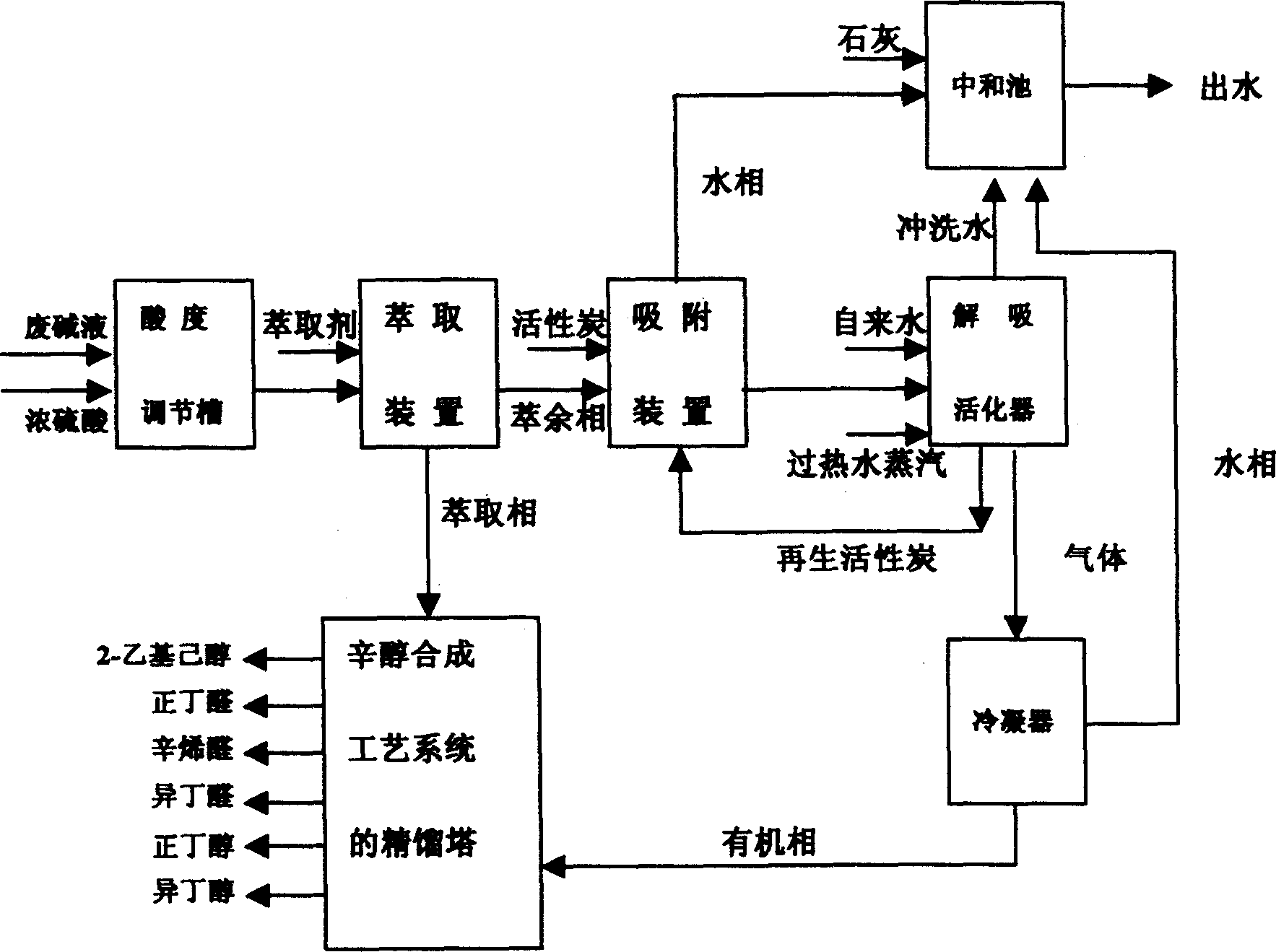Treatment process for two stage recycling alkali waste liquid drained off by process system of synthesizing octanol
A synthesis process and recovery treatment technology, which is applied in the field of environmental technology and chemical separation, can solve the problems of unexplained how to recover organic components and low removal efficiency, so as to overcome the increase of regeneration boiling point, save equipment investment and operating costs, and control significant effect
- Summary
- Abstract
- Description
- Claims
- Application Information
AI Technical Summary
Problems solved by technology
Method used
Image
Examples
specific Embodiment approach
[0017] The specific process of the present invention for processing octanol waste lye will be described in detail below in conjunction with the accompanying drawings.
[0018] Process flow of the present invention such as figure 1 As shown, within the temperature range of 45-60°C, the waste lye and concentrated sulfuric acid are stirred and mixed evenly in the acidity adjustment tank, and the pH value is adjusted to 1-4, preferably 1.5 Between ~ 3.0, the consumption of concentrated sulfuric acid is added by the ratio of concentrated sulfuric acid (93%): waste lye = 1: 19 ~ 66 (weight ratio), then waste water and extraction agent 2-ethylhexanol are reversely introduced into the extractor Or in the extraction tower. The consumption of extractant is added according to the ratio of extractant: waste water=1: 4~16 (volume ratio). The extractor is equipped with 1-3 stages of extraction units, each stage of extraction unit is composed of a mixer with a stirring device and a separat...
Embodiment 1
[0022] For temperature 50°C and COD Cr Concentration is the waste alkali liquor of 42.2g / L to carry out treatment. The weight ratio of concentrated sulfuric acid (93%) and spent lye is that both are added in the acidity adjustment tank in the ratio of 1: 19, the pH value of waste water is 1.5, waste water and extraction agent (2-ethylhexanol) are mixed with The countercurrent mode is introduced into the pulse packed tower, the waste water is introduced from the top of the extraction tower as a continuous phase, and the extractant is introduced from the bottom of the extraction tower as a dispersed phase, and the amount of the extractant is 1 / g of the volume of the spent lye. COD of the raffinate phase of the extraction operation Cr The concentration is 4.9g / L, COD Cr The removal rate was 88.4%. Pass compressed air in the adsorption tank to stir the raffinate phase with granular activated carbon with an amount of 50g / L for 1 hour and then let it stand for 20 minutes to absor...
Embodiment 2~4
[0024] Treat the waste lye with a temperature of 50°C. The weight ratio of concentrated sulfuric acid (93%) and waste lye is 1:62, the two are added in the acidity adjustment tank, the pH value of the waste water is 2.86, and the extraction agent 2-ethylhexanol and the waste water are countercurrently Import into the extraction tower equipped with secondary extraction units, add extractant to each extraction unit according to a certain volume ratio, and the mixed solution is vigorously stirred in the mixer of each extraction unit for 2 minutes, and then enters the separator After standing for 10 minutes, the extract phase and the raffinate phase were separated, and the raffinate phase and the granular activated carbon with an amount of 50g / L were stirred in the adsorption tank for 1 hour and then allowed to stand for 2 hours. See Table 1 for the treatment effects under the action.
[0025]
PUM
 Login to View More
Login to View More Abstract
Description
Claims
Application Information
 Login to View More
Login to View More - R&D
- Intellectual Property
- Life Sciences
- Materials
- Tech Scout
- Unparalleled Data Quality
- Higher Quality Content
- 60% Fewer Hallucinations
Browse by: Latest US Patents, China's latest patents, Technical Efficacy Thesaurus, Application Domain, Technology Topic, Popular Technical Reports.
© 2025 PatSnap. All rights reserved.Legal|Privacy policy|Modern Slavery Act Transparency Statement|Sitemap|About US| Contact US: help@patsnap.com


